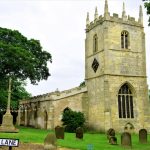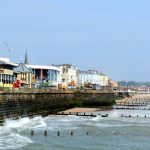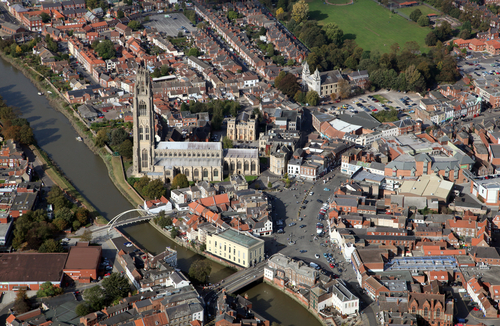
Boston is a port and market town in Lincolnshire, situated close to ‘The Wash’ on the east coast of England. The town stands on the north bank of the River Haven and east of the River Witham, some 28 miles (44 km) southeast of Lincoln and 26 miles (40 km) east of Grantham. It was once one of the most important ports in England but it’s perhaps best known for its 17th-century pilgrims who left the town to establish the settlement of Boston in the ‘new world’. In 2019, the town’s population was estimated at 46,092 with that of the wider borough being more than 70,000.
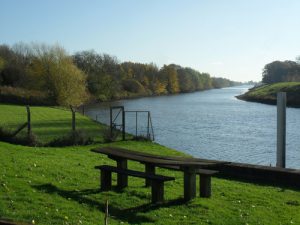
A present day view of the River Witham near Boston Image: Tony Dunn/Shutterstock.com
A Fleeting History
Early Days
There was a belief that Boston was originally a Roman settlement, however, there is no actual evidence to support the notion. The name “Boston” is thought to have been a corruption of the name of the Saxon monk ”Botolph” and the Saxon word ‘tun’, meaning settlement. That’s based on the premise that St Botolph established a monastery at Icanhoh, which is thought to have been a 7th-century settlement close to present-day Boston. Today, it is more widely accepted that Botolph’s Abbey was actually at Iken, near Aldeburgh in Suffolk. In any case, the monastery was probably destroyed sometime during the 9th century by the invading Vikings. However, there are those who still think that Botolph must have had some connection with the town, while others think the name Boston must have arisen from a different source.
Not In The The Domesday Book
We do know that Boston wasn’t mentioned in the Domesday Book in 1086 but several nearby settlements are mentioned and the town probably grew out of these. Boston may originally have formed part of the parish of Skirbeck, which in turn was part of the Manor of Drayton. Nevertheless, by the early 12th century Boston had grown into a small but busy market town with a port. By 1125, it had been granted a charter for a weekly market and an annual fair.
Emergence as a Port
By the early 13th century, Boston was already a thriving port. The town traded freely with Europe as a member of the powerful and influential Hanseatic League. While wool was the main export, salt, grain, and lead were also being shipped from the town’s dock. The main imports were wine from France and Spain, and timber and fish from Scandinavia. Boston now ranked second only to London in terms of collecting tax revenues for the crown’s coffers. During the latter part of the 13th century, four orders of monks i.e. the Dominican, Franciscan, Carmelite and Augustin, all founded monasteries in the Boston area. In 1309, the construction of St Botolph’s Church began but would take some 80 years to complete.
Boston The Wool Exporter
In 1369, Edward III declared Boston one of the exclusive ‘staple’ ports for the export wool. A system introduced by parliament to simplify the taxation of ports involved in overseas trade. In 1425, construction on St Botolph’s famous church tower, ‘The Stump’, began. It was built in stages, only being completed to its full height of 272 ft in 1510. Then on it served as a navigational aid to seafarers.
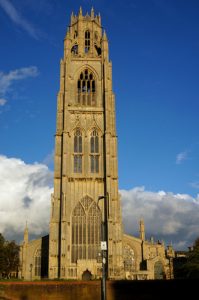
Image: Tony Dunn/Shutterstock.com
During the 15th century, the wool industry gradually began to shift away from the East Midlands to other parts of England. By 1470, the Hanseatic League was also in terminal decline and Boston’s River Haven had begun to silt up. Consequently, Boston’s port activity and the local economy, went into a steep decline.
Henry VIII’s Influence
The introduction of Henry VIII’s Dissolution of the Monasteries Act in 1536, saw the eventual closure of all Boston’s monasteries. In 1545, King Henry granted Boston a town charter, and by 1552, it had two Members of Parliament. However, Boston’s importance as a town was now much less than it had been during the 14th and 15th centuries. Though, it’s former status as a staple port and religious centre did give it kudos as a hub of intellectualism. This in turn influenced the religious beliefs and practices of many of the town’s residents.
In 1555, Boston Grammar School was built. In 1568, the Maud Foster Drain, named after a local benefactor, was constructed between Boston Haen to Cow Brygge to help with drainage of the Fens. Despite outbreaks of the plague in 1587 and 1603, the town population continued to grow. Accordingly, in 1604, James I granted Boston a new town charter.
In 1607, a group of Lincolnshire puritans led by William Brewster attempted to sail from Boston to Holland to escape religious persecution. However, the authorities were tipped off by the ship’s captain despite the fact he’d taken a bribe. The would-be immigrants were arrested at Scotia Creek for attempting unauthorised migration. However, it transgressed that most of the group were released within a month. Brewster and his followers went on to complete their endeavour the following year, leaving from the Humber.
Boston and the New World
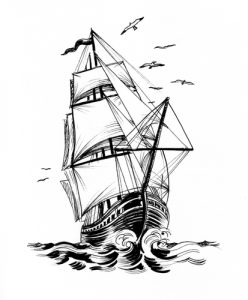
The Pilgrim Fathers set sail from Boston for ‘The New World’ in 1630
Nevertheless, Boston was to remain a hotbed of religious dissent. In 1612, John Cotton was appointed as the vicar of St Botolph’s, but his nonconformist preaching drew suspicion from the Church of England elders. However, he was a hugely popular figure and responsible for greatly increasing the attendance of St Botolph’s. Some wealthy families purposely moved to Boston just so they could attend his sermons. In 1629, backed by the Earl of Lincoln, the Massachusetts Bay Company was established. The company planned to settle a colony in the ‘new world’, where religious freedoms would be guaranteed. John Cotton became one of its most enthusiastic champions.
In the spring of 1630, a good many members of the St. Botolph’s congregation who were amongst the first to set sail for Massachusetts Bay. In September 1630, the new settlement in Massachusetts was formally named Boston, which and designated capital of the Massachusetts Bay Colony. Over the next few years, a steady stream of settlers were to make their way from Lincolnshire to Massachusetts. In 1633, John Cotton boarded ‘The Griffin’, to join his former congregation members who had already made the journey to the new colony. In all, some 10 percent of Boston’s population emigrated to Massachusetts Bay, which included the town’s MP, Richard Bellingham.
A Boston mid-17th to mid-20th century timeline
Puritanical Boston naturally sided with the parliamentarian camp at the outbreak of the English Civil War in August 1642. However, almost the whole of Lincolnshire remained under Royalist control until October 1643, when their forces were defeated at the Battle of Winceby, about 18 miles from Boston.
In 1722, renowned author and traveler, Daniel Defoe visited Boston, reporting it to be ‘large and populous’. In 1725, Boston’s Customs House was built. The following year, Fydell House was constructed for local merchant William Fydell, who would later become town mayor. In 1774, the first bank opened in the town. In 1776, the town’s Commissioners, an early quasi-local council, were appointed under an Act of Parliament. The late 18th century saw ‘The Fens’ being drained on an industrial scale, producing particularly rich and fertile land. This soon saw Boston’s farmers able to sell almost all their grain and vegetable produce to London’s markets
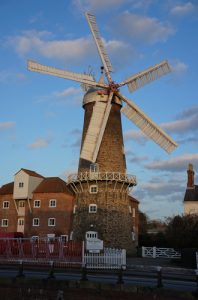
Maud Foster’s Windmill was completed in 1819 Image: Tony Dunn/Shutterstock.com
In 1801, Boston’s population was recorded as 5,926, a large market town by the standards of the time. The early 19th century saw the town’s port trade flourish. Maud Foster’s Windmill was completed in 1819. From 1825, Boston had gas lighting, and from 1845, piped water.
The Railway Reaches Boston
In 1848, the railway arrived in Boston, seeing it become a stop on the mainline from London to the North. However, that was only until the East Coast Main Line was constructed shortly afterwards. The Great Northern Railway sited their main locomotive works at Boston, but in 1852, the facility was relocated to Doncaster. In 1855, a volunteer fire brigade was formed and the Corn Exchange was built. In 1884, a new dock was constructed on the River Haven, enabling the town to regain some of its former status as an important commercial and fishing port.
20th Century Boston
At the turn of the 20th century, the population of Boston stood at around 15,000, and life for its citizens was gradually improving. The first cinema was opened in 1910 and a new Town Bridge was completed in 1913. WW1 saw several hospital ships docked at the town’s port, where some 4,000 sick and wounded soldiers were treated. In 1919, Central Park was purchased by the local authority for public use. In 1921, a war monument was erected at the Bargate Memorial Gardens to commemorate those who died in the Great War. In 1924, the town gained electrical street lighting, and the County Hall was built 3 years later. The 1920’s also the first council houses being built in Boston.
The interwar years saw Boston lose much of its fishing trade but it continued to tick over as a port, mostly exporting grain and fertiliser, and importing timber. During WW2, a total of 17 civilians were killed from bombing raids by the Luftwaffe.
Postwar Boston
The town grew steadily after the war ended and by 1951, Boston’s population had risen to around 24,000, much of which was due to boundary changes. 1960s were quite uneventful, however, there was a bridge built over the River Haven in 1966. and in the 1970s transport links improved massively in 1978 when the John Adams dual-carriageway was opened and in 2004 The Pescod Shopping Centre opened in 2004, attracting many new retail outlets to the town.
Modern Era Boston
Today the town’s population is around 46,092 and the wider borough swells this to over 70,000. Quite a leap for a town that didn’t make the Doomsday Book! Boston’s most important industries are agricultural food production, particularly potatoes, and road haulage and logistics. Boston’s port still handles more than one million tons of cargo per year, mostly importing steel and timber, whilst exporting grain and materials for recycling. Fishing, tourism and light industry make up the rest of the local economy.
The Boston to Peterborough Wetland Corridor (B2PWC), formerly known as The Fens Waterway Link, is currently under construction with an aim of introducing navigable canals for pleasure cruising across Lincolnshire and Cambridgeshire. It is hoped that project completion will see the area rivalling the Norfolk Broads.
Getting To Boston
By Road
From the North, the easiest way to Boston is via the A1(M)/A1 and then the A17. From the A1 turn off at Newark and follow the A17 all the way to Boston. From the South and Midlands, take the M1, turn off at Nottingham onto the A52, following it all the way into Boston. From the South East, take the A1(M)/A1, then turn on to the A52 at Grantham. From the Humberside area take the A16.
By Train
Boston is served by East Midlands Railway on the Poacher Line between Grantham and Skegness. The town’s station is connected to London’s King’s Cross via Nottingham. The hourly service between Nottingham and Boston takes about 90 mins. From most other major destinations you will need to change trains at Grantham. There’s an hourly service from Grantham to Boston with a journey time of about 50 minutes.
By Bus
National Express runs one coach daily from London Victoria directly to Boston, with a scheduled journey time of around 4 hours. Getting to Boston from other parts of the country will probably mean making at least one, if not two, changes, thus overall journey times may be quite long.
By Air
Humberside Airport is 48 miles (77 km) from Boston but there are few scheduled flights. East Midlands International Airport is the closest large facility at 77 miles (123 km). The easiest method of travel from the Midlands to Boston is by train, via Nottingham (see above).
Sport In Boston
Football
Boston United FC are the town’s foremost football team. Nicknamed ‘The Pilgrims’, they play in the National League North, the 6th tier of English football. They play their home games at the new (2020) Boston Community Stadium.
The town’s second club, Boston Town are nicknamed ‘The Poachers’, and play in the United Counties Football League. They play home games at the DWB Stadium on Tattershall Road.
Rugby
Boston RFC first team play their rugby in the Midlands 3 East (North) League. They play home games at the Princess Royal Arena at Boardsides.
Rowing
Boston Rowing Club are a large and thriving club benefitting from one of the best stretches of water for rowing in the country. It caters for journeymen through to would-be Olympians, beginners to old hands. Aspiring rowers need to be 12 years+. One of Boston’s major sporting events takes place here in mid-September. The 33-mile (53 km) Boston Rowing Marathon, a race between Lincoln and Boston, which attracts teams from all over the world.
Sailing
Witham Sailing Club and its clubhouse are located on the banks of the River Witham. The club owns its own boats so you don’t need to be a boat owner to partake. It’s also a Royal Yachting Association (RYA) training centre, so instruction and courses are available throughout the year. You can sail on the River Witham or out in ‘The Wash’.

Boston has a large and thriving rowing club
Notable People
A few notable people with a connection to Boston include:
- Arthur Lucan (1885 – 1954) – was an English actor who was best known in his drag persona as Old Mother Riley. He starred in the role on stage, screen and radio and made a series of comedy films between the late 1930s and early 1950s. Arthur moved to Boston when he was 5 years old from nearby Sibsey.
- Catherine Mumford (1829 – 1890) – founded the Christian Mission, the forerunner to the Salvation Army, which she also co-founded with her husband William Booth. Lord Hattersley, a biography, said that “She was probably the most extraordinary woman in Victorian England”. Catherine moved to Boston as a young child.
- John Cotton (1585 – 1652) – was appointed as the vicar of St. Botolph’s church in 1612. A puritan non-conformist, he encouraged many of his congregation to emigrate to the ‘new world’. In July 1633 he set sail for Boston, Massachusetts himself, where he was ordained as the first vicar. A role he fulfilled to his death in 1652.
- John Motson – is an almost legendary, popular football commentator. Affectionately known by all and sundry as ‘Motty’, he began his commentary career in 1971. He was born in July 1945 in Salford, Lancashire but was baptised in Boston. He also often holidayed in the town as a child and is a reputed Boston United fan.
Did you know?
- Boston lies directly north of Greenwich on the Prime Meridian at a distance of 102 miles (163 km).
- St Botolph’s church tower (The Stump) makes the building the tallest of all parish churches in England.
- Legendary guitarist Jimi Hendrix and his band performed at Boston’s Gliderdrome on 25th March 1967. It’s one of only a hand full of UK venues where the cult figure played live.
- The first month of WWI saw a number of trawlers from Boston being sunk by the German navy. Up to 70 men are thought to have drowned.
- Boston is twinned with Boston, Massachusetts. Not too surprising given their historical links.
- Their other twin towns are Laval in France and Hakusan in Japan.
Things To Visit In Boston
There are a surprising number of things to see and do in and around the town. Here are a few recommendations:
- St Botolph’s Church – dates from the early 14th century. The 272 ft (83 m) tower, known locally as the ‘Boston Stump’, is the town’s most prominent landmark. The church has notable stain glass windows and a medieval painted ceiling. Open daily, it’s free to enter but charges apply to the tower. There’s a coffee shop & gift shop on site.
- Boston Guildhall – was build in the 14th century as St Mary’s Guild. Closed down by Henry VIII, it saw new use as the town hall and courthouse. There are many historic decorative features and exhibits throughout the building. The free museum is open from Wednesday to Saturday.
- Pilgrim Fathers Memorial – the small granite obelisk is located 10 minutes downriver from the town. It marks the very spot where the Pilgrim Fathers first attempted to set sail for the Netherlands in 1607.
- Bubblecar Museum – displays a collection of some 50 classic small cars, i.e. those less than 700 cc. It’s the only such museum in the UK. Makes include the Isetta, Bond, Bamby, Frisky and Reliant, mostly dating from the 50s and 60s, the bubble car era. There are also retro shops, a gift shop and a cafe. It opens Friday to Sunday and Bank Holidays.
- Maud Foster’s Mill – is one of the tallest windmills in the UK. The 25 m high five-sailed structure was built in 1819 on the Maud Foster Drain, a waterway used to transport grain and flour. It ceased work operations in 1948 but is now open Wednesdays and Saturdays for visitors.
Places to Go
- The Wash – is where Boston’s River Haven flows to, forming one of the largest estuaries in the country. It’s viewed as the most significant estuary in the country for many forms of sea life. Additionally, it’s salt marshes and mudflats are both breeding and feeding grounds for multiple species of birds.
- The Marketplace – the irregularly shaped market square is one of the largest in England and has operated for at least 900 years. The 120 or so stalls are open on Wednesdays and Saturdays, selling the full gambit of things you’d expect and more besides.
Where to stay?
There’s a decent amount of reasonably priced accommodation in and around Boston. A broad guide to prices for 2 adults sharing is:
Inn/B & B/Guesthouse/Lodge/Hotel: £50 – 100
Luxury Hotel: £100 – 150
A limited number of holiday lets/apartments are also available with variable price, dependant of location and standard.
Thinking of moving To Boston?
Are you thinking of moving to Boston? Over the last 12 months, properties in Boston have fetched an average price of £161,100. The majority of sales in the town during the last year were detached houses, which sold for an average price of £212,100. Semi-detached houses sold for an average price of £139,300, terraced houses fetched £115,900 and flats £89,500. There was almost no difference in house prices in Boston for when comparing prices for the last 12 months to the previous year.


